From million-dollar behemoth federal grants to small one-time grants awarded to local individuals, no two grants are alike.
But the vast majority of grant programs have a few things in common. First and foremost: they all contribute to the greater good and create positive outcomes in the communities that they serve.
They also all share a similar lifecycle: a set of steps that sees the grant go from first idea to final impact.

What is the grant lifecycle?
The grant lifecycle is the series of events that brings each grant program from beginning to end. It starts with an idea for a grant, progresses to the award of the grant, and concludes with an analysis of impact of the grant.
There are two approaches to thinking about the grant lifecycle:
The grant lifecycle is often broken down into three major phases: pre-award planning, award implementation, and post-award management stages.
We can also visualize the grant lifecycle as a great big figure eight, with the ten-step grantee cycle looping in one direction and the ten-step grantor cycle looping around in the other.
The two loops intersect at a shared event: the acceptance of the grant application.
In this post, we’ll take a closer look at both ways of exploring the grant lifecycle, as well as how this lifecycle can be managed and streamlined through grant management software.
Contents
- The grant lifecycle for grantors
- The grant lifecycle for grantees
- The grant lifecycle in three phases
- How to streamline the grant lifecycle for grantors
The grant lifecycle for grantors
Half of the grant lifecycle takes place from the grantor’s point of view: the organization offering the grant program and funds. For both grantors and grantees, the goal is the same: getting the maximum impact out of the funds. But for grantors, the lion’s share of work tends to come before grant funding is awarded.
Here are each of the ten basic steps in the cycle:
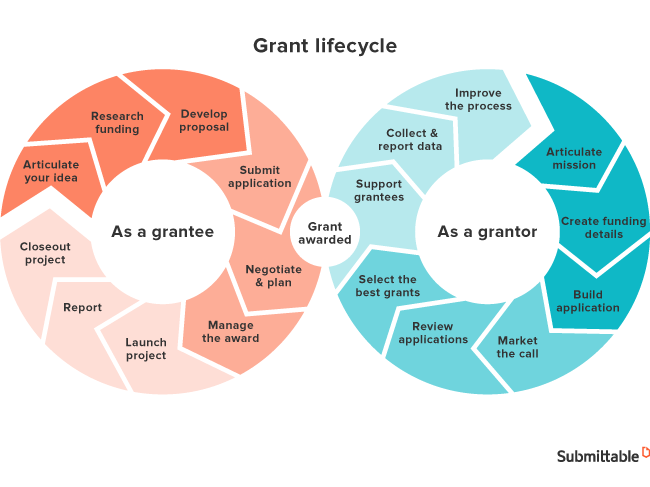
1. Articulate the mission
Grantees and grantors both start the same way: envisioning their goals and articulating their philosophy and mission. The real magic happens when grantees and grantors with similar goals and missions find each other.
2. Create funding details
Once your goals are in place, grant organizations and foundations need to get practical by outlining their funding abilities, budgets, guidelines, and timelines.
All of this information should be solidly in place before approaching the next step.
3. Create a grant application
Once your guidelines and mission are crystal clear, you can build your online grant application form. Submittable’s drag-and-drop form builder can make that easy.
Be careful to go for balance: don’t make the application so long that it’s a barrier to apply for the grant, but don’t make the application so sparse that your review team has trouble evaluating applicants.
Consider adding auto-labels to your forms in Submittable so that you can filter and organize your applications as the review process begins.
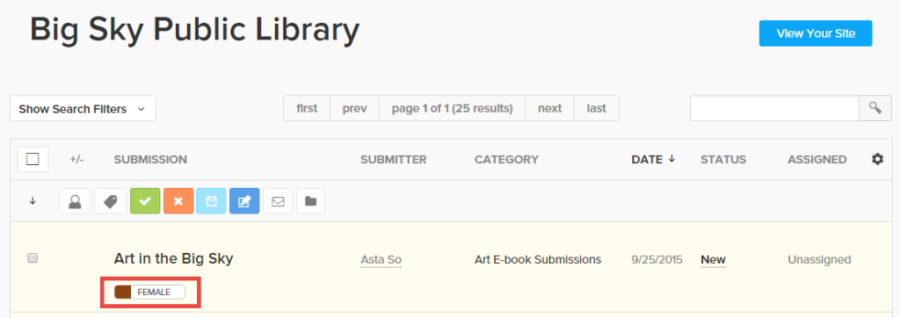
Submittable’s eligibility quizzes can automatically exclude grantees that don’t qualify, saving everyone time and effort.
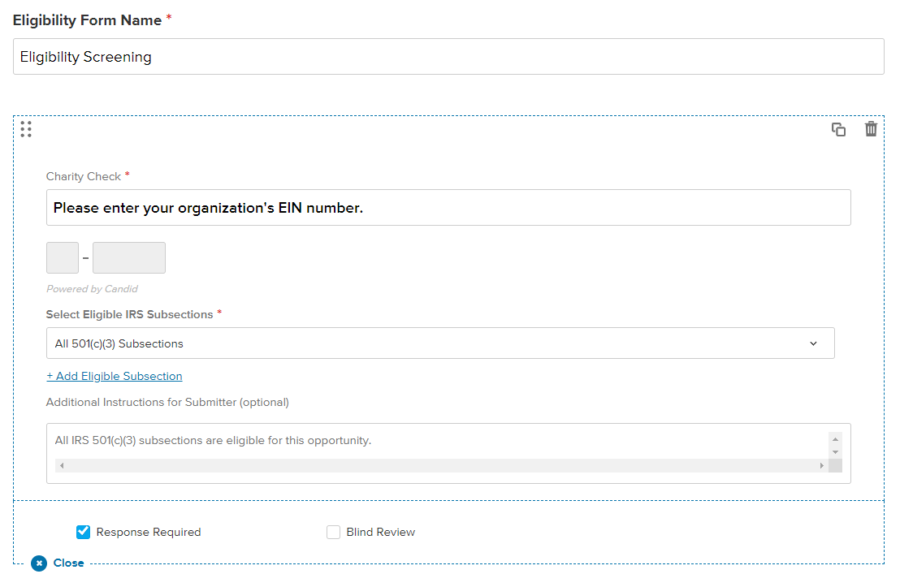
4. Market the call for grant proposals
Once you’ve created your online grant application form, you can create a branded landing page for your call for applications. This is another step you can quickly handle with Submittable.
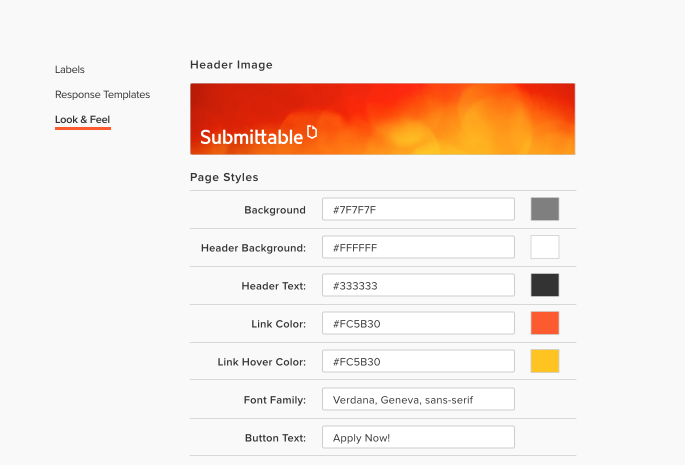
Include all of the information and guidelines that anyone will need to learn about and apply for your funds.
Then, start shouting about your opportunity from the rooftops. Here are just a few places to consider to advertise your grant:
- Publications that cater to nonprofit organizations and foundations
- Online forums or conferences frequented by your audience
- Google ads and other pay-per-click opportunities
- Your own blog
- Local or industry-specific media outlets
If you use Submittable, you can also promote your grant in the Discover search tool, which allows grantees to find the best opportunities for them available at the time.
Want to streamline your grant management process from start to finish?
Submittable can save you time and money by bringing it all together.
5. Review grant applications
While the steps in the grant lifecycle are generally the same for all organizations, the grant application review process can vary significantly depending on the size of the grant and the size of the organization.
Some organizations may have a small, internal review team and one simple review stage. Other organizations, like federal grantors may have hundreds of reviewers, spanning different specialties, who review groups of grant applications in different stages.
Whether your grant review process is simple or complex, Submittable’s software can streamline it and make it uniform, increasing fairness and removing kinks, from beginning to end.
Our multi-round review feature can help you move applications from the initial stage through to the end of the process, making it easier to find the best fits in a logical and fair way.
At the same time, anonymous review options can hide applicant or reviewer names or both, minimizing bias and putting everyone on a level playing field.
Finally, auto labels can organize a mountain of applications into neat piles instantly, with no busy work from you.
https://www.youtube.com/watch?v=xTu71dffNwg&feature=youtu.be
6. Select the best grants
Once your review process is over, all that’s left to do is share the news. Make sure to tell all applicants about their new at the same time, and in a timely manner.
Submittable’s bulk email options means that mass communication is as simple as sending a single email, and fair to all involved. Let all of the people who didn’t make the cut know at the same time, and in the same way. Then email those you’ve selected (you can choose whether to add personal details or send the same letter).
Once grantees are selected, you may wish to collect additional information from them before you release the funds. Use Submittable’s Additional Forms feature to request tax information, more detailed plans, or reporting information.
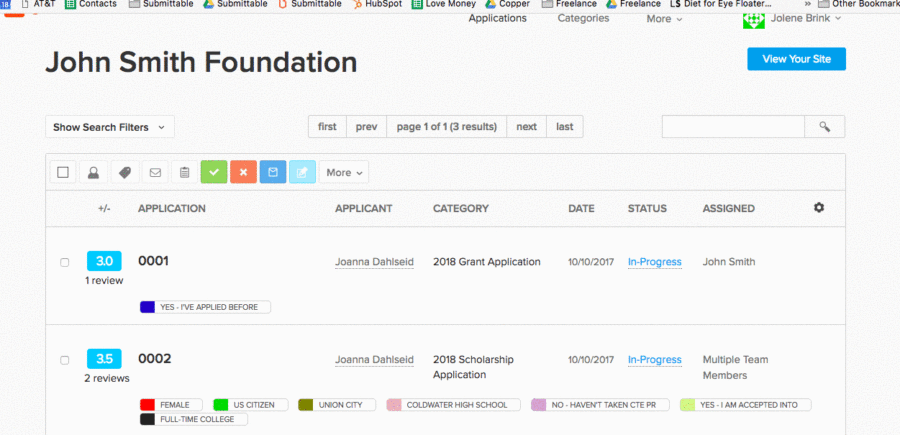
7. Award grant funding
This is what grants are all about: getting money from the people who have it to the people who need it to do good.
You can track when and how much funding you’ve awarded with Submittable’s Funds feature.
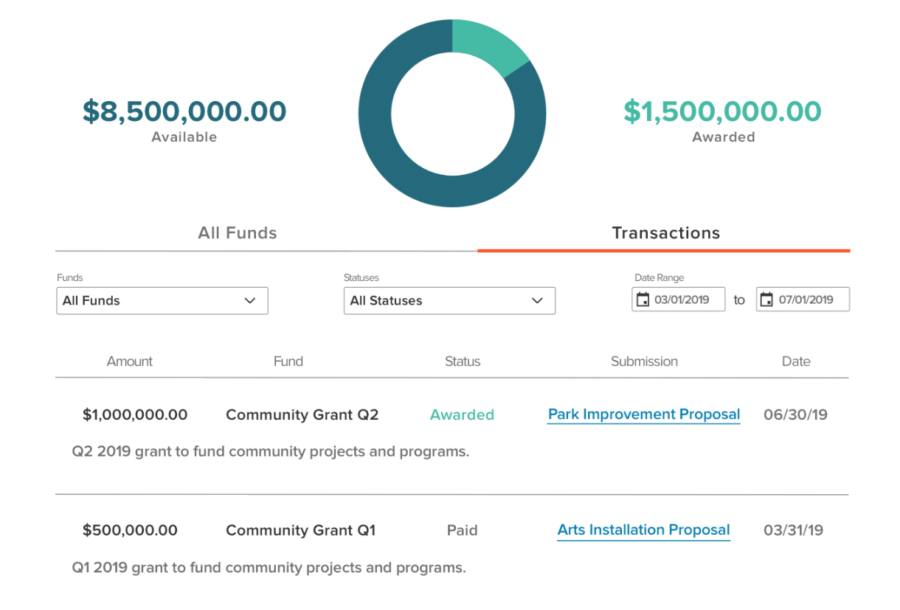
8. Support your grantees
The amount of support that you give your grantees depends a lot on your vision for your grant, as well as the contract that you’ve signed with them about your level of involvement.
In some cases, the grant money might be given with almost no follow-up, while in other cases, you may work extremely closely with your grantee throughout the process. As grantmaking evolves, more involvement is becoming more common so that organizations can increase their impact.
9. Collect and review data
During this step of the process, you want to review and research all of your data from Steps 1-7.
Realize that you don’t just want to look at how your grantees fared from analyzing their reports and information. You also want to analyze the data from your application process, so that you can improve that vital step and select the best grantees possible.
Submittable’s reporting tools allow you to better understand how your review process shook out, from demographic data, to acceptance percentages, to anything that you asked in your forms.

10. Improve the process
Take an honest look at the data and research that you collected in Step 8. Even if you had a great grant cycle and impacted your community, how could you reach even further next cycle?
Search for places to increase efficiencies, shorten timelines, and save person power. Review your budget and pinpoint places you could spend fewer resources—or places where spending more could improve your final outcome.
Turn your insights into actionable changes that you can implement before you start the process over.
The grant lifecycle for grantees
The grant lifecycle might seem simpler from the perspective of a grantee—all you have to do is apply for a grant and then spend the money, right?
But it’s not that straightforward or easy. The grantees who get the most out of their awards—not to mention the grantees that are awarded the most funding—are the ones who carefully plan their projects and then carefully analyze their results.
The timeline may be broken down into 10 steps:
1. Articulate your idea
Your idea should come before you pinpoint a grant that would help and not the other way around.
Examine your organization’s mission and philosophy as well as your unique skills, knowledge bank, and abilities. Clarify how you want to help, how you can make the most impact, and what resources you’ll need to complete your program, project, initiative, or plan.
During this step, you want to be as specific as possible while also leaving a lot of room for change, growth, and unexpected shifts in plans. Be flexible but have a clear goal.
2. Research funding options
Once you have your goal clearly in mind, you need to match your project with grant programs.
Quickly hone in on good fits for grants by reading the guidelines carefully and eliminating grants that you’re not eligible for.
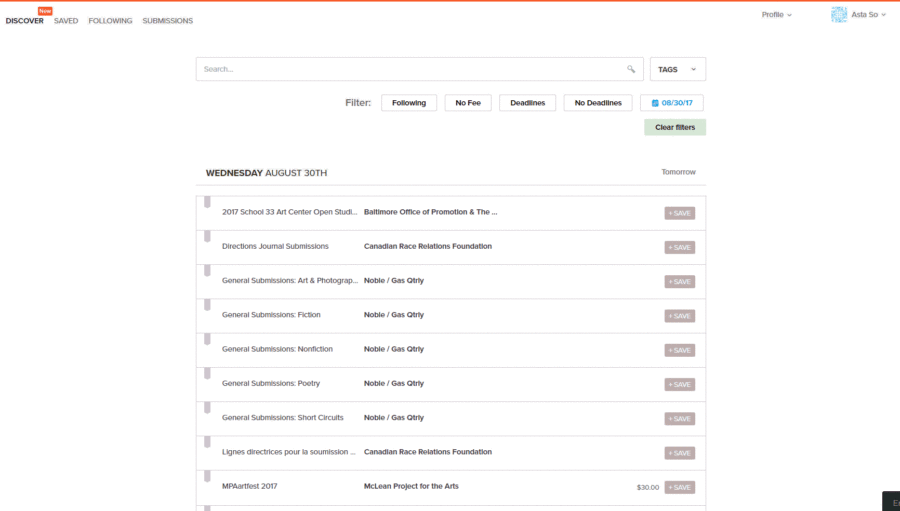
3. Develop your proposal
Should you mold your grant proposal to fit the grant, or find a grant that fits your proposal?
The answer lies somewhere in between. It’s rare that you’ll find a grant that’s a perfect fit for your objectives. But it’s not a great idea to modify any of your big goals or philosophies just to get funding.
Go for balance: it’s okay to stress one part of your mission when you apply for one grant and another part of your mission when you apply for another grant. But the heart of your proposal should never change significantly.
Here’s a general list of information that you’ll want to include while putting your proposal together—even before you have specific grants in mind.
- Your organization’s mission statement.
- Your organization’s history and accomplishments.
- Your organization’s current programming and activities.
- Your proposal’s goals and objectives.
- Your proposal’s design and strategy.
- Your proposal’s budget and timeline.
- Your proposal’s measurable outcomes.
4. Submit your application
If you’re applying for multiple sources of funding, you’ll almost certainly need to modify your proposal for each grant and application process.
Note that different grants can have wildly different cycles and timelines, as well as wildly different requirements and application processes. It may be helpful to create a spreadsheet of deadlines and required documentation so that you don’t miss opportunities.
Also: give yourself a generous amount of time to fill out applications—even if the meat of your proposal is already written. You don’t want to lose out on grant money due to a tricky application process or a technicality.
Submittable believes that grant application software should make it as easy as possible for eligible applicants to submit proposals. To help, our platform has a number of applicant-friendly features, including the ability to save drafts, as well as a collaborative submission tool that allows multiple users to work on proposals.

5. Receive grant approval
One of the most rewarding moments of the grant lifecycle is the moment you are awarded funding. But don’t rest on your laurels.
In many ways, the moment that you are granted funding is the moment that the real hard work beings: you now have to follow through with your proposal and show just how impactful your work can be.
If you’re not chosen for funding, don’t walk away from the experience without learning what you can. Many foundations and grantmakers will give you feedback from the application process, letting you know if you didn’t qualify, if you failed to follow guidelines, or if there was some other issue in your proposal.
Submittable’s grant management software allows grantors to share their comments, questions, and reviews directly with applicants so that everyone can learn and grow for the next grant cycle.
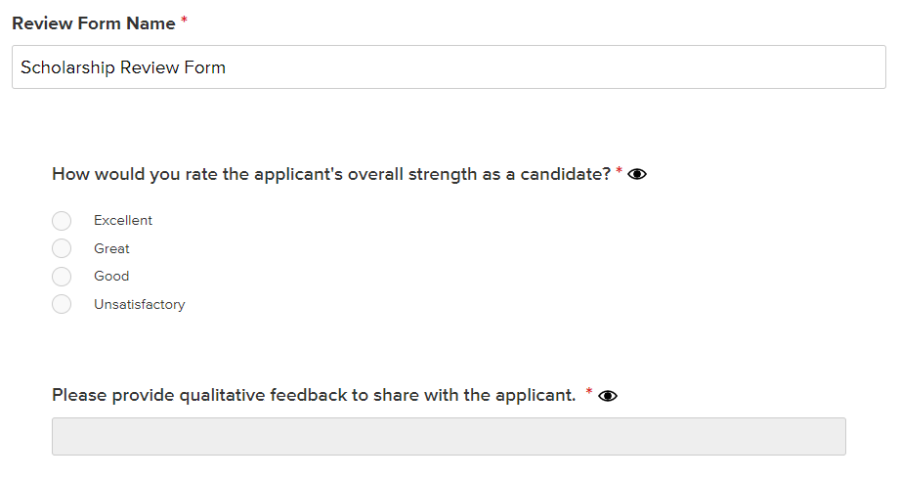
6. Negotiate and plan
Grant approval often isn’t as easy as getting a check in the mail.
Especially as grantmaking evolves, grant management has become more of a partnership between the grantee and grantor, and getting funding is simply the first step before a collaboration begins.
During this vital planning stage, you’ll work with the grant foundation or organization to determine the details of your plan, solidify the timeline, and nail down exactly how tracking and reporting will work.
This is not the time to overpromise, exaggerate, or get ahead of yourself. Make plans based on all of the knowledge and data that you have, and keep in mind that hitting your goals will be important to securing more funding in the future.
7. Manage the award
It’s finally time to get down to work.
Return to that golden document, your original proposal, to guide you through the actual labor of your grant, with the understanding that things will change and not every deadline and budget item will pan out.
A few things to keep in mind:
Practice good tracking
Tracking can seem like an annoyance when you’re trying to get your project off the ground and actually do good in the community. But you will be endlessly thankful for the tracking you do today when you’re putting together reports on your progress tomorrow.
Your grantors are your partners
If you run into barriers or snags as you work, don’t keep them to yourself. Keeping grantmakers informed and up-to-date, even with bad news, is imperative to your relationship and success. At best, they are there to help. At worst, you need to let them know if you won’t hit one or more of your goals.
Be ready for audit requests
Reporting doesn’t all come at the end of the project—expect your grantors to track results throughout the process in order to ensure the project is moving in the right direction.
8. Use your funds (appropriately)
This article might begin to sound like a broken record about tracking, but that should only stress its importance.
Keep careful track of where your funds are used and how it matches up with your proposed budget. There are likely somewhat strict parameters about how you can use funds (although this depends heavily on your grant’s guidelines and negotiations), and you need to follow them.
9. Report your results
Once your work is done, it’s time to focus on the results and impact.
If you’ve been tracking results throughout your initiative, analysis will be easier.
While the primary importance of reporting is proving to your foundation that you’ve held up your end of the deal, what you learn should be of the utmost importance to your organization as well.
You can see what went wrong, what went right, and why. It’ll help you better understand exactly what went down and how you can improve your work over the next grant cycle.
Also remember: reporting isn’t just for and about your grantor, it’s about your other financial supporters, the people you help, and the greater community. Be sure to share your results in a public way, whether it’s a press release, blog post, public meeting, newsletter, or email.
10. Close out the project
The grant award you received likely included closeout requirements—a final correspondence where you share final numbers, wins, and takeaways.
This is where all of your tracking and reporting comes in handy. It’s also where you can get a good overview of what you’ve accomplished and how the grant helped.
Closing out a grant project is also the best time for reflecting and planning for your next cycle.
Ask yourself:
- What could you have done differently for increased impact?
- How could you better streamline your process?
- Were there places that you went over or under budget?
The grant lifecycle in three phases
In addition to thinking about the grant lifecycle as the intersection of grantee steps with grantor steps, you can also think about it in three distinct phases:
- Preaward planning
- Award implementation
- Post-award management
Let’s take a closer look.
Phase 1: Pre-award planning
Although the first phase of the grant lifecycle may only last between one and four months, funding organizations have the potential to waste the largest amount of time during this step, which includes budgeting, planning, the application process, and application selection.
For both grantees and grantors, all of these steps can become time consuming and resource intensive without effective management.
Rather than allowing candidates to submit paper materials or asking staff members to track applications manually, or patching together several applications and platforms, organizations can save substantial time by using a single software system like Submittable that handles every step of the process within one framework.
Just within the first phase of the grant lifecycle, Submittable can help you:
- Create an online application form
- Create a landing page with grant guidelines
- Eliminate ineligible applications quickly
- Advertise your call for applications
- Review and select your applications
- Communicate with reviews and applicants

Phase 2: Award implementation
The second lifecycle phase tends to be the shortest, usually lasting just one month, but it has the potential to make a major impact.
During the award phase, organizations inform applicants about the results of the grant, work closely with grant recipients to finalize details, and release funds.
While this phase may seem relatively straightforward, organizations can encounter roadblocks if they fail to collect sufficient information during the application phase. To streamline the award phase, grantors should gather candidates’ complete contact information during the application process so that they can easily communicate via mail, email, or telephone.
Creating a time-sensitive process for securing required signatures and disbursing grant funds to eligible accounts can also ensure that your team efficiently completes this phase of the lifecycle.
Grant management software can help grantors avoid missing deadlines or wasting time on unnecessary communications.
During this phase, grantors can use Submittable to:
- Inform grantees that they have been awarded a grant.
- Complete necessary paperwork with grantees.
- Collect information about the legal details of the grant.
- Survey grantees for needed demographic information.
Phase 3: Post-award management
The final phase of the grant lifecycle is generally the longest and may span multiple years, depending on the specifics of the grant.
Since an organization’s staff, priorities, and capabilities may change during this period, it’s essential to develop a streamlined process for overseeing the post-award phase.
Naturally, the reports and results that this phase generates can be effective public relations materials, making this a key component of the lifecycle.
Rather than spending time communicating with recipients individually or risking data loss by conducting award management in a secondary system, organizations can streamline the process by integrating third-party applications with submission software.
With an integrated grants management system like Submittable, organizations can easily allow automated communication throughout the final phase of the grant.
Using Submittable’s labeling options and integrations with Zapier, teams can take post-award management to an entirely new level. This functionality enables organizations to generate tasks and reminders automatically, making scheduling simple and streamlined, even over a multi-year period.
With a combination of straightforward app integration, easy automation, and advanced planning, teams can save time and resources throughout the lengthy post-award process. By streamlining this crucial data-gathering step, organization’s funding opportunities will have the potential to do the most good.
How to streamline the grant lifecycle for grantors
For every inefficiency in your grant lifecycle, you lose time, money, resources, and person power. Like a tire that’s not fully inflated, your process will shed wasted energy that could be used to increase the impact of your funds.
An online grant management system for grantorsfor can help. Submittable is designed to make each step automated and uniform, erasing guesswork, subjectivity, and bias while increasing speed, fairness, and accuracy.
Submittable can specifically streamline:
The grant application process
Create a branded landing page and guidelines as well as an accessible online application form. Add an eligibility quiz that bars unqualified applicants from submitting. Collect all the information you need without having to keep track of paper applications or sort through emails.
Grant application review
Submittable helps grantmakers make the right decision, faster:
- Create teams of reviewers and assign them specific groups of applications that then move through multiple stages of review.
- Have your review team work remotely or at the same table—or a combination of the two.
- Make either applications or reviewers anonymous to fight discrimination and unconscious biases.
Grantee and grantor communication
Instead of making your inbox a nightmare, Submittable’s in-app communication tools make sending messages and bulk messages easy, whether you’re communicating with an applicant or a reviewer. Keep a perfect record of your communications in the same place with your applications, and never leave anyone uninformed.
Fund tracking
Funds are at the heart of grantmaking. With our funds tool, ensure that every grantee has the resources they need to hit their goals—and that your coffers are at the right levels. Know exactly what you have to spend and to give.
Impact reporting
Reporting is an increasingly important aspect of grantmaking, and it’s especially vital to improving the next round of funding. Submittable’s reporting features allow organizations to see their mission getting accomplished on screen with graphs, charts, and solid numbers.
Through every phase of the grant lifecycle, use Submittable to streamline your process
For every grant your organization offers, completing the funding lifecycle requires extensive planning, implementation, and management. While you can’t eliminate any essential lifecycle stages entirely, you can simplify and qualify each step.
Why cost your team time and resources when it’s easy to take a smarter approach to the grant process? Put these tips into practice today to start streamlining each step of your organization’s grant lifecycle, one after another.
